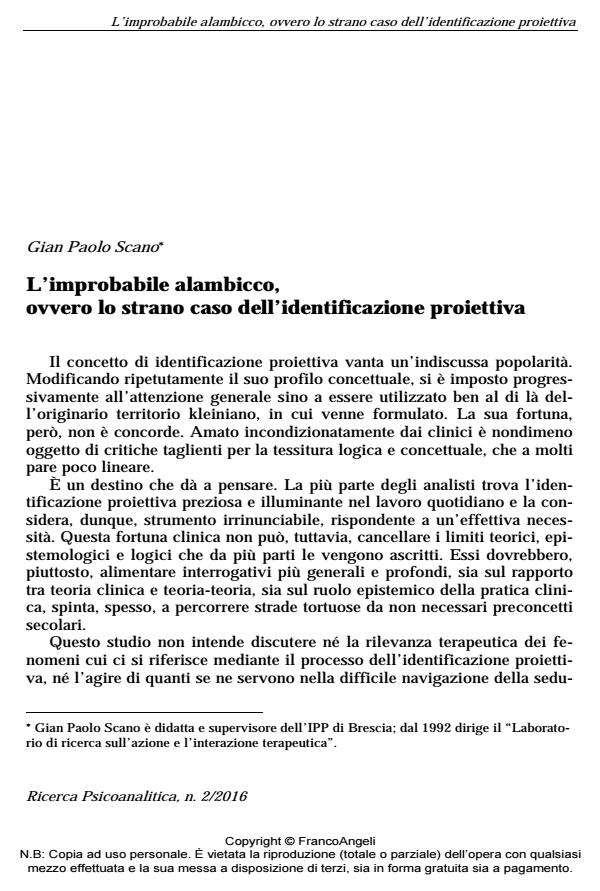The improbable alembic, or the strange case of projective identification
Journal title RICERCA PSICOANALITICA
Author/s Gian Paolo Scano
Publishing Year 2016 Issue 2016/2 Language Italian
Pages 27 P. 93-119 File size 117 KB
DOI 10.3280/RPR2016-002007
DOI is like a bar code for intellectual property: to have more infomation
click here
Below, you can see the article first page
If you want to buy this article in PDF format, you can do it, following the instructions to buy download credits

FrancoAngeli is member of Publishers International Linking Association, Inc (PILA), a not-for-profit association which run the CrossRef service enabling links to and from online scholarly content.
The widely shared opinion that projective identification describes ubiquitous and easily observable phenomena is unfounded. When analyzed, this concept appears based on a weird epistemology that from the theoretical point of view seems to contradict the current concept of transference and countertransference that touch upon the same clinical material. Projective identification rather than describing a phenomenon or a mysterious psychic performance of the therapeutic couple, aims at solving in an improper way the most difficult problem posed by traditional theory that, based on the assumption of the intrapsychic point of view, finds it hard to explain the intersubjective substance of the therapeutic relation. Considering interactions as intrapsychic processes, it allows to bypass the need to change the theoretical picture, avoiding the problem of saying what theoretical and clinical changes would be required if one wanted to accept the statement that the object of theory and of therapy are interactions rather than the intrapsychic experiences of an isolated mind.
Keywords: Projective identification, epistemology, transference and countertransference, intersubjectivity, therapeutic relation
- Aron L. (1996). Trad. it.: Menti che si incontrano. Milano: Cortina.
- Baranger W. (1971). Position y objeto en la obra de Melanie Klein. Buenos Aires: Kagierman.
- Bion W.R. (1959a). Trad. it.: Esperienze nei gruppi. Roma: Armando, 1971.
- Bion W.R. (1959b). Trad. it.: Attacchi al legame. Analisi degli schizofrenici e metodo psicoanalitico. Roma: Armando, 1970.
- Bolko M., Merini A. (1991). Osservazioni sulla identificazione proiettiva: “Througt the looking glass”. Psic.Sc. Um., 25, 4: 19-34.
- Di Chiara G., Flegenheimer F. (1985). Identificazione proiettiva. Riv. di psicoan., 31, 2, 233-243.
- Eagle M. N. (2000). Trad. it.: Una valutazione critica delle attuali concettualizzioni su transfert e controtransfert, Psic. Sc. Um., XXXIV, 2.
- Ferro A. (1987). Il mondo alla rovescia. Riv. di Psicoan. 33, 1, 59-77.
- Gill M.M. (1994). Trad. it.: Psicoanalisi in transizione. Milano: Cortina, 1996.
- Grinberg L. (1962). On a specific aspect of countertransference due to the patient’s projective identification. Int. J. of Phychoanal., 43: 436-440.
- Heimann P. (1950). On Counter-Transference. Int. J. of Psychoanal., 31: 81-84.
- Klein M. (1932). Trad. it.: La psicoanalisi dei bambini. Firenze: Martinelli, 1969.
- Klein M. (1946). Notes on some schizoid mechanisms. Trad. it. in: Scritti, 1921-1950. Torino: Boringhieri, 1978.
- Klein M. (1955). On identification. Trad. it. In: Nuove vie della psicoanalisi. Milano: Il Saggiatore, 1966.
- Malin A., Grotstein J. (1966). Projective Identification in the Therapeutic Process. Int. J. Psycho-Anal., 47: 26-31.
- Massidda G.B. (2009). Identificazione proiettiva. Milano: Lampi di stampa.
- Meltzer D. (1967). Trad. it.: Il processo psicoanalitico. Roma: Armando, 1973.
- Ogden T.H. (1979). On Projective Identification. Int. J. Psychoanal., 60: 357-373.
- Ogden T.H (1991). Trad. it.: L’identificazione proiettiva e la tecnica psicoterapeutica. Roma: Astrolabio, 1994.
- Racker H. (1952). Observaciones sobre la contratransferencia como instrumento tecnico. Rev. Psicoanal, 9.
- Racker H. (1953). A contribution to the problem of counter-transference. Int. J. Psychoan., 34.
- Racker H. (1968). Trad. it.: Studi sulla tecnica psicoanalitica. Transfert e controtransfert. Roma: Astrolabio, 1970.
- Rosenfeld H. (1969). Sull’identificazione proiettiva, Riv. di psicoan. 26, 1: 118-139.
- Sandler (1976). Trad. it.: Controtransfert e risonanza di ruolo. In: Albarella C., Donadio M. (a cura di), Il controtransfert. Napoli: Liguori, 1986.
- Scano G.P. (2006). L’interazione come oggetto formale della psicoanalisi. Internet ed.: www.psychomedia.it/pm/indther/psanndx1.htm.
- Scano G. P. (2013). Narrazioni e narranti: verso una teoria generale dell’interazione terapeutica. In: Cavicchioli G. (a cura di). Io-Tu-Noi. L’intersoggettuività duale e gruppale in psicoanalisi. Milano: FrancoAngeli.
- Scano G.P. (2015). La mente del corpo: intenzionalità e inconscio della coscienza, Milano: FrancoAngeli.
- Searles H. (1963). Trad. it.: La psicosi di traslazione nella psicoterapia della schizofrenia cronica. In: Scritti sulla schizofrenia. Torino: Borinhieri, 1974.
- Turillazzi Manfredi S. (1985). L’unicorno. Saggio sulla fantasia e l’oggetto nel concetto di identificazione proiettiva. Riv. di psicoan., 31, 4: 462-477.
- Wallerstein R. S. (1988). Trad. it.: Una o molte psicoanalisi?. Gli argonauti, 1989, 43: 253-276.
- Wallerstein R. S. (1990). Trad. it.: Psicoanalisi: gli elementi comuni, in: Wallerstein R. S. (a cura di Lang M.) Psicoanalisi e psicoterapia. Milano: FrancoAngeli, 1993.
- Winnicott D. W. (1949). Trad. it.: L’odio nel controtransfert. In: Albarella C., Donadio M. (a cura di), Il controtransfert. Saggi psicoanalitici. Napoli: Liguori Editore, 1998
- Vincolo e significato Gian Paolo Scano, in Ricerca Psicoanalitica /2022
DOI: 10.4081/rp.2022.672
Gian Paolo Scano, L’improbabile alambicco, ovvero lo strano caso dell’identificazione proiettiva in "RICERCA PSICOANALITICA" 2/2016, pp 93-119, DOI: 10.3280/RPR2016-002007